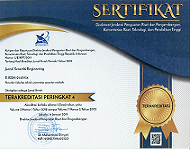Proses Adsorpsi Amonia dengan Karbon Aktif dari Cangkang Kelapa Sawit (Palm Shell) Teraktivasi H2SO4
Keywords:
active carbon, palm kernel shells, adsorption, ammonia, sulfuric acidAbstract
Activated carbon is a porous material that has a high surface area capable of adsorbing various substances. The process of making activated carbon uses palm oil shell biomass waste with a carbonization method and is activated using H2SO4. Activated carbon is used as an adsorbent in the Ammonia (NH3) adsorption process. Variations in the adsorption process were used, namely, H2SO4 activation concentration (5, 10, 15 and 20%) and adsorption contact time for (15, 30, 45, and 60 minutes). The optimum adsorption capacity of 12.97% was shown in the activated carbon adsorbent activated by 20% H2SO4 with a contact time of 30 minutes. The optimum result of reducing the NH3 concentration from 100 ppm to 50 ppm occurred at 15 and 20% activation with a contact time of 60 minutes. Variations in activation concentration and contact time affect the adsorption capacity so that NH3 can be absorbed by activated carbon.
References
[1] M. R. Rayhan, H. Marzuki, dan L. L. Legasari, “Analisis Kadar Amonia Bebas pada Pupuk Urea menggunakan Metode Autotitrator di PT. Pupuk Sriwidjaja Palembang," S a i n s Jurnal Kimia dan Pendidikan Kimia,” vol. 13, hal. 22–28, 2024.
[2] Ekawati, Christine JK. Alternatif bahan baku arang aktif. Rena Cipta Mandiri, 2023.
[3] D. R. Zalsabitha dan A. Susanti, “Seleksi Proses dan Penentuan Kapasitas Pabrik Karbon Aktif dari Serbuk Gergaju Kayu,” vol. 9, no. 9, hal. 251–257, 2023.
[4] LA Ifa, Takdir Syarif, Darnengsih. Bioadsorben dan Aplikasinya. Yayasan Pendidikan Cendekia Muslim, 2021.
[5] Lubis, Rizka Alfi Fadhilah, Hafni Indriati Nasution, and Moondra Zubir. "Production of activated carbon from natural sources for water purification." Indonesian Journal of Chemical Science and Technology 3.2 (2020): 67-73.
[6] J. Guo, W. S. Xu, Y. L. Chen, dan A. C. Lua, “Adsorption of NH 3 onto activated carbon prepared from palm shells impregnated with H2SO4,” J. Colloid Interface Sci., vol. 281, no. 2, hal. 285–290, 2005, doi: 10.1016/j.jcis.2004.08.101.
[7] Auliya, Riri, Ni Luh Gede Ratna Juliasih, and Rinawati Rinawati. "Pembuatan dan karakterisasi karbon aktif dari kulit pisang kepok (Musa Paradisiaca L.) sebagai adsorben senyawa Polisiklik Aromatik Hidrokarbon Fenantrena." Analit: Analytical and Environmental Chemistry (2018).
[8] Tani, Djefry. Pembuatan dan Karakterisasi Karbon Aktif. Penerbit NEM, 2023.
[9] S. Sethupathi, M. J. Bashir, Z. A. Akbar, dan A. R. Mohamed, “Biomass-based Palm Shell Activated Carbon and Palm Shell Carbon Molecular Sieve as Gas Separation Adsorbents,” Waste Manag. Res., vol. 33, no. 4, hal. 303–312, 2015, doi: 10.1177/0734242X15576026.
[10] Zulkania, Ariany, Aliya Nurhasanah, and Dwita Cahaya Pratiwi. "Pengaruh Delignifikasi Pada Karakteristik Karbon Aktif dan Biosorben dari Limbah Kulit Pisang Kepok." Eksergi 21.2 (2024): 103-110
[11] Ramadhani, Lia F., et al. "Teknologi aktivasi fisika pada pembuatan karbon aktif dari limbah tempurung kelapa." Jurnal Teknik Kimia 26.2 (2020): 42-53.
Downloads
Published
Issue
Section
License
Copyright (c) 2025 Afit Sri Wahyudi WR, Erika Dwi Oktaviani (Author)

This work is licensed under a Creative Commons Attribution 4.0 International License.












